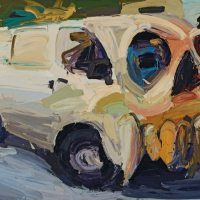22. BEN QUILTY

On the road with Ben Quilty, we come face to face with a country on edge. The cars in his paintings the Torana, the Landcruiser, even the mini-van carry the weight of a certain culture, a certain sense of being in the world. They tell a story about masculinity and freedom, mortality and danger. Arrayed before us like models, they dont move but theyre far from still.
When he was a young artist, not yet a household name, not yet an Archibald-winner, not yet an activist wrestling with the contradictions of the world, Quilty observed that much of his work had been focused on young men looking for initiation. The vehicle for this rite of passage was clear.
For us initiation was performed inside a car. Beer in hand we became valued members of a society and, as the motor screamed, the dizziness of expectation awakened the adult in us.1
This painting, Skull 3, comes from a particular moment in Quiltys evolution. He had already come to the attention of the art world with a series of Torana portraits, all conveyed in a muscular, palpable impasto that was quickly becoming his trademark.2 Those images, soaked in testosterone and adolescent assurance, were impressions of a particular kind of Australian culture. This was car culture, of course, the kind of scene that carries a real potency for young men on the hunt for adventure and meaning. Like the young man in Kenthurst, north-west of Sydney, cruising around at night in a Torana, feeling like he has something to prove, a picture of rebellion and risk.
In Quiltys hands, the car becomes a symbol of mortality, mateship and masculinity, wrote curator Lisa Slade, now a years-long collaborator, a vanitas motif or reminder of the transience of life.3
At this time, Quilty had also been looking closely at the presence of the skull in the western world, especially in male culture. Paintings like Skull Landscape and Elwood Park Farewell Winter, as well as the Skullburger works, all engage with the inevitability of death and decay. Here was the memento mori, reconfigured for suburbia. As a young artist he looked within himself to ask questions about identity. In particular: what does it mean to be a man in Australia? Fifteen years later, as matters of consent become part of the political debate in the nations capital, these questions have taken on an even greater urgency.
Quilty is fascinated by the conversations about belonging that circulate, however refracted, through Australian life. His fascination continues through other subjects and themes, from Captain Cook to the war in Afghanistan, from Aboriginal massacre sites to grotesque accounts of modern madness.
And we know through his words, and through his advocacy that the artist feels deeply about many of the causes to which he has dedicated so much time. The refugee crisis, the death penalty, indigenous disadvantage: Quilty has long used his profile to draw attention to injustice both domestically and abroad. But in his art, can we detect a hint of uncertainty and equivocation creeping into the frame? His pictures ripple with energy, but some are enigmatic, a Rorschach test for the rest of us. These are images offered up to a country yet to make peace with itself.
In 2019, to mark Quiltys recent survey exhibition, a mid-career show that travelled to three states, Art Gallery of New South Wales curator Justin Paton wrote about the powerfully mixed feelings contained in the work: how restlessly, even as they speak their messages, they question arts power to speak. For the ways in which static objects such as paintings move us are highly unpredictable, and the ways in which those feelings then move us into action are more unpredictable still.4
In this painting, necessarily large, Quilty brings together the skull and the vehicle in this case, a mini-van, the kind of machine that might be used to carry tradies between jobs or backpackers between cities. A vehicle like that is easy enough to use but hard to love. Its not a Torana, thats for sure. But Quilty brings us close. His van, with its unsettling, anthropomorphic anxiety, is now a source of menace or road rage. We cant see inside, apart from a smudge of blue on the right eye, where the windscreen might have been, but we can imagine a driver there a young man, most likely, scowling behind the wheel, waiting for his moment.
Its a surreal image, a distortion like the giant warships in a Studio Ghibli film, at once familiar and otherworldly, everyday and disquieting. The van is presented in three-quarter view. The brush-strokes appear more physical as the van morphs into a skull. And those teeth at the front: theyre the most intimidating of all. A warning to stand back, or perhaps to stand by.
Footnotes
1. Ben Quilty, quoted in Ben Quilty Live! Interpretive Guide, University of Queensland Art Museum, Brisbane, 2009, accessed May 2021: http://asset.artmuseum.uq.edu.au/docs/BenQuiltyInterpretiveGuide.pdf
2. Turner, B., Ben Quilty on the Burden of Being Australias Artist from Central Casting, The Sydney Morning Herald: Good Weekend, Sydney, 23 February 2019
3. Slade, L., Ben Quilty Live! Interpretive Guide, University of Queensland Art Museum, Brisbane, 2009
4. Paton, J., Painting the Tangle, in Ben Quilty, Penguin Books, Australia, 2019, p.57
Ashleigh Wilson is the author of Brett Whiteley: Art, Life and the Other Thing.